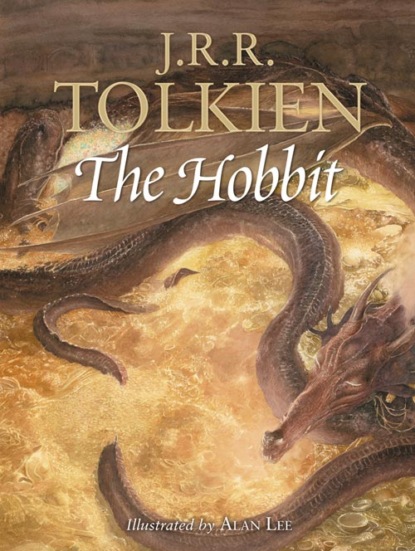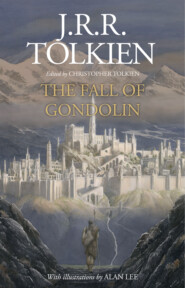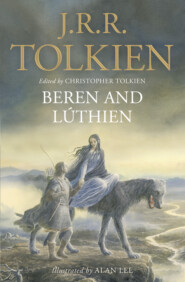По всем вопросам обращайтесь на: info@litportal.ru
(©) 2003-2024.
✖
The Hobbit: Illustrated by Alan Lee
Автор
Год написания книги
2019
Настройки чтения
Размер шрифта
Высота строк
Поля
The Hobbit: Illustrated by Alan Lee
Alan Lee
First ever illustrated eBook of the classic bestseller featuring more than 60 colour paintings and pencil drawings by the award-winning artist, Alan Lee, Conceptual Designer on Peter Jackson’s THE HOBBIT: AN UNEXPECTED JOURNEY.Bilbo Baggins is a hobbit who enjoys a comfortable, unambitious life, rarely travelling further than the pantry of his hobbit-hole in Bag End. But his contentment is disturbed when the wizard, Gandalf, and a company of thirteen dwarves arrive on his doorstep one day to whisk him away on an unexpected journey ‘there and back again’. They have a plot to raid the treasure hoard of Smaug the Magnificent, a large and very dangerous dragon…The prelude to The Lord of the Rings, The Hobbit has sold many millions of copies since its publication in 1937, establishing itself as one of the most beloved and influential books of the twentieth century.This new eBook edition is illustrated throughout in gorgeous watercolour and delicate pencil by Alan Lee, the Oscar-winning Conceptual Designer on Peter Jackson’s films, THE HOBBIT: AN UNEXPECTED JOURNEY and THE HOBBIT: THERE AND BACK AGAIN.
THE HOBBIT
CONTENTS
COVER PAGE (#ue112398d-1f40-5c5d-938f-e0a1b2c82deb)
TITLE PAGE (#u56ef286f-e8aa-5d4b-9859-5e33d161b8a1)
MAPS (#ub509b755-326a-59bf-ae93-81d9102aa9be)
AUTHOR’S NOTE (#u9bb9cb14-d260-5789-942a-3fb41c8f62e7)
CHAPTER I: AN UNEXPECTED PARTY (#u73e04221-5bf1-5230-acdf-4f2a1e8fc4ba)
CHAPTER II: ROAST MUTTON (#u3768e074-eaf0-5698-b622-dfa6bb46ccdb)
CHAPTER III: A SHORT REST (#ub5743a70-4a88-5342-b5aa-cf5e42a353d5)
CHAPTER IV: OVER HILL AND UNDER HILL (#ud34cfb71-c150-5893-be09-45fc7c2bafcf)
CHAPTER V: RIDDLES IN THE DARK (#udec2d0f6-dd0d-50e0-aabe-768cc31fba50)
CHAPTER VI: OUT OF THE FRYING-PAN INTO THE FIRE (#litres_trial_promo)
CHAPTER VII: QUEER LODGINGS (#litres_trial_promo)
CHAPTER VIII: FLIES AND SPIDERS (#litres_trial_promo)
CHAPTER IX: BARRELS OUT OF BOND (#litres_trial_promo)
CHAPTER X: A WARM WELCOME (#litres_trial_promo)
CHAPTER XI: ON THE DOORSTEP (#litres_trial_promo)
CHAPTER XII: INSIDE INFORMATION (#litres_trial_promo)
CHAPTER XIII: NOT AT HOME (#litres_trial_promo)
CHAPTER XIV: FIRE AND WATER (#litres_trial_promo)
CHAPTER XV: THE GATHERING OF THE CLOUDS (#litres_trial_promo)
CHAPTER XVI: A THIEF IN THE NIGHT (#litres_trial_promo)
CHAPTER XVII: THE CLOUDS BURST (#litres_trial_promo)
CHAPTER XVIII: THE RETURN JOURNEY (#litres_trial_promo)
CHAPTER XIX: THE LAST STAGE (#litres_trial_promo)
WORKS BY J.R.R. TOLKIEN (#litres_trial_promo)
COPYRIGHT (#litres_trial_promo)
ABOUT THE PUBLISHER (#litres_trial_promo)
Author's Note (#ulink_15b8dfe2-ff7f-567f-8253-fa5348f33059)
This is a story of long ago. At that time the languages and letters were quite different from ours of today. English is used to represent the languages. But two points may be noted. (1) In English the only correct plural of dwarf is dwarfs, and the adjective is dwarfish. In this story dwarves and dwarvish are used* (#litres_trial_promo), but only when speaking of the ancient people to whom Thorin Oakenshield and his companions belonged. (2) Orc is not an English word. It occurs in one or two places but is usually translated goblin (or hobgoblin for the larger kinds). Orc is the hobbits’ form of the name given at that time to these creatures, and it is not connected at all with our orc, ork, applied to sea-animals of dolphin-kind.
Runes were old letters originally used for cutting or scratching on wood, stone, or metal, and so were thin and angular. At the time of this tale only the Dwarves made regular use of them, especially for private or secret records. Their runes are in this book represented by English runes, which are known now to few people. If the runes on Thror’s Map are compared with the transcriptions into modern letters† (#ulink_cb7b4976-d423-58b3-8b91-87bd69098e19)† (#ulink_ed4f8455-596e-5005-9121-d6c9717b826c), the alphabet, adapted to modern English, can be discovered and the above runic title also read. On the Map all the normal runes are found, except
for X. I and U are used for J and V. There was no rune for Q (use CW); nor for Z (the dwarf-rune
may be used if required). It will be found, however, that some single runes stand for two modern letters: th, ng, ee; other runes of the same kind (
ea and
st) were also sometimes used. The secret door was marked D
. From the side a hand pointed to this, and under it was written:
The last two runes are the initials of Thror and Thrain. The moon-runes read by Elrond were:
On the Map the compass points are marked in runes, with East at the top, as usual in dwarf-maps, and so read clockwise: E(ast), S(outh), W(est), N(orth).
CHAPTER I (#ulink_a6e8839f-a721-5761-b2a0-5152826e7e86)
An Unexpected Party (#ulink_a6e8839f-a721-5761-b2a0-5152826e7e86)
In a hole in the ground there lived a hobbit. Not a nasty, dirty, wet hole, filled with the ends of worms and an oozy smell, nor yet a dry, bare, sandy hole with nothing in it to sit down on or to eat: it was a hobbit-hole, and that means comfort.
It had a perfectly round door like a porthole, painted green, with a shiny yellow brass knob in the exact middle. The door opened on to a tube-shaped hall like a tunnel: a very comfortable tunnel without smoke, with panelled walls, and floors tiled and carpeted, provided with polished chairs, and lots and lots of pegs for hats and coats—the hobbit was fond of visitors. The tunnel wound on and on, going fairly but not quite straight into the side of the hill—The Hill, as all the people for many miles round called it—and many little round doors opened out of it, first on one side and then on another. No going upstairs for the hobbit: bedrooms, bathrooms, cellars, pantries (lots of these), wardrobes (he had whole rooms devoted to clothes), kitchens, dining-rooms, all were on the same floor, and indeed on the same passage. The best rooms were all on the left-hand side (going in), for these were the only ones to have windows, deep-set round windows looking over his garden, and meadows beyond, sloping down to the river.
This hobbit was a very well-to-do hobbit, and his name was Baggins. The Bagginses had lived in the neighbourhood of The Hill for time out of mind, and people considered them very respectable, not only because most of them were rich, but also because they never had any adventures or did anything unexpected: you could tell what a Baggins would say on any question without the bother of asking him. This is a story of how a Baggins had an adventure, and found himself doing and saying things altogether unexpected. He may have lost the neighbours’ respect, but he gained—well, you will see whether he gained anything in the end.
The mother of our particular hobbit—what is a hobbit? I suppose hobbits need some description nowadays, since they have become rare and shy of the Big People, as they call us. They are (or were) a little people, about half our height, and smaller than the bearded Dwarves. Hobbits have no beards. There is little or no magic about them, except the ordinary everyday sort which helps them to disappear quietly and quickly when large stupid folk like you and me come blundering along, making a noise like elephants which they can hear a mile off. They are inclined to be fat in the stomach; they dress in bright colours (chiefly green and yellow); wear no shoes, because their feet grow natural leathery soles and thick warm brown hair like the stuff on their heads (which is curly); have long clever brown fingers, good-natured faces, and laugh deep fruity laughs (especially after dinner, which they have twice a day when they can get it). Now you know enough to go on with. As I was saying, the mother of this hobbit—of Bilbo Baggins, that is—was the famous Belladonna Took, one of the three remarkable daughters of the Old Took, head of the hobbits who lived across The Water, the small river that ran at the foot of The Hill. It was often said (in other families) that long ago one of the Took ancestors must have taken a fairy wife. That was, of course, absurd, but certainly there was still something not entirely hobbitlike about them, and once in a while members of the Took-clan would go and have adventures. They discreetly disappeared, and the family hushed it up; but the fact remained that the Tooks were not as respectable as the Bagginses, though they were undoubtedly richer.
Not that Belladonna Took ever had any adventures after she became Mrs. Bungo Baggins. Bungo, that was Bilbo’s father, built the most luxurious hobbit-hole for her (and partly with her money) that was to be found either under The Hill or over The Hill or across The Water, and there they remained to the end of their days. Still it is probable that Bilbo, her only son, although he looked and behaved exactly like a second edition of his solid and comfortable father, got something a bit queer in his make-up from the Took side, something that only waited for a chance to come out. The chance never arrived, until Bilbo Baggins was grown up, being about fifty years old or so, and living in the beautiful hobbit-hole built by his father, which I have just described for you, until he had in fact apparently settled down immovably.
By some curious chance one morning long ago in the quiet of the world, when there was less noise and more green, and the hobbits were still numerous and prosperous, and Bilbo Baggins was standing at his door after breakfast smoking an enormous long wooden pipe that reached nearly down to his woolly toes (neatly brushed)—Gandalf came by. Gandalf! If you had heard only a quarter of what I have heard about him, and I have only heard very little of all there is to hear, you would be prepared for any sort of remarkable tale. Tales and adventures sprouted up all over the place wherever he went, in the most extraordinary fashion. He had not been down that way under The Hill for ages and ages, not since his friend the Old Took died, in fact, and the hobbits had almost forgotten what he looked like. He had been away over The Hill and across The Water on businesses of his own since they were all small hobbit-boys and hobbit-girls.
All that the unsuspecting Bilbo saw that morning was an old man with a staff. He had a tall pointed blue hat, a long grey cloak, a silver scarf over which his long white beard hung down below his waist, and immense black boots.
“Good Morning!” said Bilbo, and he meant it. The sun was shining, and the grass was very green. But Gandalf looked at him from under long bushy eyebrows that stuck out further than the brim of his shady hat.
Alan Lee
First ever illustrated eBook of the classic bestseller featuring more than 60 colour paintings and pencil drawings by the award-winning artist, Alan Lee, Conceptual Designer on Peter Jackson’s THE HOBBIT: AN UNEXPECTED JOURNEY.Bilbo Baggins is a hobbit who enjoys a comfortable, unambitious life, rarely travelling further than the pantry of his hobbit-hole in Bag End. But his contentment is disturbed when the wizard, Gandalf, and a company of thirteen dwarves arrive on his doorstep one day to whisk him away on an unexpected journey ‘there and back again’. They have a plot to raid the treasure hoard of Smaug the Magnificent, a large and very dangerous dragon…The prelude to The Lord of the Rings, The Hobbit has sold many millions of copies since its publication in 1937, establishing itself as one of the most beloved and influential books of the twentieth century.This new eBook edition is illustrated throughout in gorgeous watercolour and delicate pencil by Alan Lee, the Oscar-winning Conceptual Designer on Peter Jackson’s films, THE HOBBIT: AN UNEXPECTED JOURNEY and THE HOBBIT: THERE AND BACK AGAIN.
THE HOBBIT
CONTENTS
COVER PAGE (#ue112398d-1f40-5c5d-938f-e0a1b2c82deb)
TITLE PAGE (#u56ef286f-e8aa-5d4b-9859-5e33d161b8a1)
MAPS (#ub509b755-326a-59bf-ae93-81d9102aa9be)
AUTHOR’S NOTE (#u9bb9cb14-d260-5789-942a-3fb41c8f62e7)
CHAPTER I: AN UNEXPECTED PARTY (#u73e04221-5bf1-5230-acdf-4f2a1e8fc4ba)
CHAPTER II: ROAST MUTTON (#u3768e074-eaf0-5698-b622-dfa6bb46ccdb)
CHAPTER III: A SHORT REST (#ub5743a70-4a88-5342-b5aa-cf5e42a353d5)
CHAPTER IV: OVER HILL AND UNDER HILL (#ud34cfb71-c150-5893-be09-45fc7c2bafcf)
CHAPTER V: RIDDLES IN THE DARK (#udec2d0f6-dd0d-50e0-aabe-768cc31fba50)
CHAPTER VI: OUT OF THE FRYING-PAN INTO THE FIRE (#litres_trial_promo)
CHAPTER VII: QUEER LODGINGS (#litres_trial_promo)
CHAPTER VIII: FLIES AND SPIDERS (#litres_trial_promo)
CHAPTER IX: BARRELS OUT OF BOND (#litres_trial_promo)
CHAPTER X: A WARM WELCOME (#litres_trial_promo)
CHAPTER XI: ON THE DOORSTEP (#litres_trial_promo)
CHAPTER XII: INSIDE INFORMATION (#litres_trial_promo)
CHAPTER XIII: NOT AT HOME (#litres_trial_promo)
CHAPTER XIV: FIRE AND WATER (#litres_trial_promo)
CHAPTER XV: THE GATHERING OF THE CLOUDS (#litres_trial_promo)
CHAPTER XVI: A THIEF IN THE NIGHT (#litres_trial_promo)
CHAPTER XVII: THE CLOUDS BURST (#litres_trial_promo)
CHAPTER XVIII: THE RETURN JOURNEY (#litres_trial_promo)
CHAPTER XIX: THE LAST STAGE (#litres_trial_promo)
WORKS BY J.R.R. TOLKIEN (#litres_trial_promo)
COPYRIGHT (#litres_trial_promo)
ABOUT THE PUBLISHER (#litres_trial_promo)
Author's Note (#ulink_15b8dfe2-ff7f-567f-8253-fa5348f33059)
This is a story of long ago. At that time the languages and letters were quite different from ours of today. English is used to represent the languages. But two points may be noted. (1) In English the only correct plural of dwarf is dwarfs, and the adjective is dwarfish. In this story dwarves and dwarvish are used* (#litres_trial_promo), but only when speaking of the ancient people to whom Thorin Oakenshield and his companions belonged. (2) Orc is not an English word. It occurs in one or two places but is usually translated goblin (or hobgoblin for the larger kinds). Orc is the hobbits’ form of the name given at that time to these creatures, and it is not connected at all with our orc, ork, applied to sea-animals of dolphin-kind.
Runes were old letters originally used for cutting or scratching on wood, stone, or metal, and so were thin and angular. At the time of this tale only the Dwarves made regular use of them, especially for private or secret records. Their runes are in this book represented by English runes, which are known now to few people. If the runes on Thror’s Map are compared with the transcriptions into modern letters† (#ulink_cb7b4976-d423-58b3-8b91-87bd69098e19)† (#ulink_ed4f8455-596e-5005-9121-d6c9717b826c), the alphabet, adapted to modern English, can be discovered and the above runic title also read. On the Map all the normal runes are found, except
for X. I and U are used for J and V. There was no rune for Q (use CW); nor for Z (the dwarf-rune
may be used if required). It will be found, however, that some single runes stand for two modern letters: th, ng, ee; other runes of the same kind (
ea and
st) were also sometimes used. The secret door was marked D
. From the side a hand pointed to this, and under it was written:
The last two runes are the initials of Thror and Thrain. The moon-runes read by Elrond were:
On the Map the compass points are marked in runes, with East at the top, as usual in dwarf-maps, and so read clockwise: E(ast), S(outh), W(est), N(orth).
CHAPTER I (#ulink_a6e8839f-a721-5761-b2a0-5152826e7e86)
An Unexpected Party (#ulink_a6e8839f-a721-5761-b2a0-5152826e7e86)
In a hole in the ground there lived a hobbit. Not a nasty, dirty, wet hole, filled with the ends of worms and an oozy smell, nor yet a dry, bare, sandy hole with nothing in it to sit down on or to eat: it was a hobbit-hole, and that means comfort.
It had a perfectly round door like a porthole, painted green, with a shiny yellow brass knob in the exact middle. The door opened on to a tube-shaped hall like a tunnel: a very comfortable tunnel without smoke, with panelled walls, and floors tiled and carpeted, provided with polished chairs, and lots and lots of pegs for hats and coats—the hobbit was fond of visitors. The tunnel wound on and on, going fairly but not quite straight into the side of the hill—The Hill, as all the people for many miles round called it—and many little round doors opened out of it, first on one side and then on another. No going upstairs for the hobbit: bedrooms, bathrooms, cellars, pantries (lots of these), wardrobes (he had whole rooms devoted to clothes), kitchens, dining-rooms, all were on the same floor, and indeed on the same passage. The best rooms were all on the left-hand side (going in), for these were the only ones to have windows, deep-set round windows looking over his garden, and meadows beyond, sloping down to the river.
This hobbit was a very well-to-do hobbit, and his name was Baggins. The Bagginses had lived in the neighbourhood of The Hill for time out of mind, and people considered them very respectable, not only because most of them were rich, but also because they never had any adventures or did anything unexpected: you could tell what a Baggins would say on any question without the bother of asking him. This is a story of how a Baggins had an adventure, and found himself doing and saying things altogether unexpected. He may have lost the neighbours’ respect, but he gained—well, you will see whether he gained anything in the end.
The mother of our particular hobbit—what is a hobbit? I suppose hobbits need some description nowadays, since they have become rare and shy of the Big People, as they call us. They are (or were) a little people, about half our height, and smaller than the bearded Dwarves. Hobbits have no beards. There is little or no magic about them, except the ordinary everyday sort which helps them to disappear quietly and quickly when large stupid folk like you and me come blundering along, making a noise like elephants which they can hear a mile off. They are inclined to be fat in the stomach; they dress in bright colours (chiefly green and yellow); wear no shoes, because their feet grow natural leathery soles and thick warm brown hair like the stuff on their heads (which is curly); have long clever brown fingers, good-natured faces, and laugh deep fruity laughs (especially after dinner, which they have twice a day when they can get it). Now you know enough to go on with. As I was saying, the mother of this hobbit—of Bilbo Baggins, that is—was the famous Belladonna Took, one of the three remarkable daughters of the Old Took, head of the hobbits who lived across The Water, the small river that ran at the foot of The Hill. It was often said (in other families) that long ago one of the Took ancestors must have taken a fairy wife. That was, of course, absurd, but certainly there was still something not entirely hobbitlike about them, and once in a while members of the Took-clan would go and have adventures. They discreetly disappeared, and the family hushed it up; but the fact remained that the Tooks were not as respectable as the Bagginses, though they were undoubtedly richer.
Not that Belladonna Took ever had any adventures after she became Mrs. Bungo Baggins. Bungo, that was Bilbo’s father, built the most luxurious hobbit-hole for her (and partly with her money) that was to be found either under The Hill or over The Hill or across The Water, and there they remained to the end of their days. Still it is probable that Bilbo, her only son, although he looked and behaved exactly like a second edition of his solid and comfortable father, got something a bit queer in his make-up from the Took side, something that only waited for a chance to come out. The chance never arrived, until Bilbo Baggins was grown up, being about fifty years old or so, and living in the beautiful hobbit-hole built by his father, which I have just described for you, until he had in fact apparently settled down immovably.
By some curious chance one morning long ago in the quiet of the world, when there was less noise and more green, and the hobbits were still numerous and prosperous, and Bilbo Baggins was standing at his door after breakfast smoking an enormous long wooden pipe that reached nearly down to his woolly toes (neatly brushed)—Gandalf came by. Gandalf! If you had heard only a quarter of what I have heard about him, and I have only heard very little of all there is to hear, you would be prepared for any sort of remarkable tale. Tales and adventures sprouted up all over the place wherever he went, in the most extraordinary fashion. He had not been down that way under The Hill for ages and ages, not since his friend the Old Took died, in fact, and the hobbits had almost forgotten what he looked like. He had been away over The Hill and across The Water on businesses of his own since they were all small hobbit-boys and hobbit-girls.
All that the unsuspecting Bilbo saw that morning was an old man with a staff. He had a tall pointed blue hat, a long grey cloak, a silver scarf over which his long white beard hung down below his waist, and immense black boots.
“Good Morning!” said Bilbo, and he meant it. The sun was shining, and the grass was very green. But Gandalf looked at him from under long bushy eyebrows that stuck out further than the brim of his shady hat.








